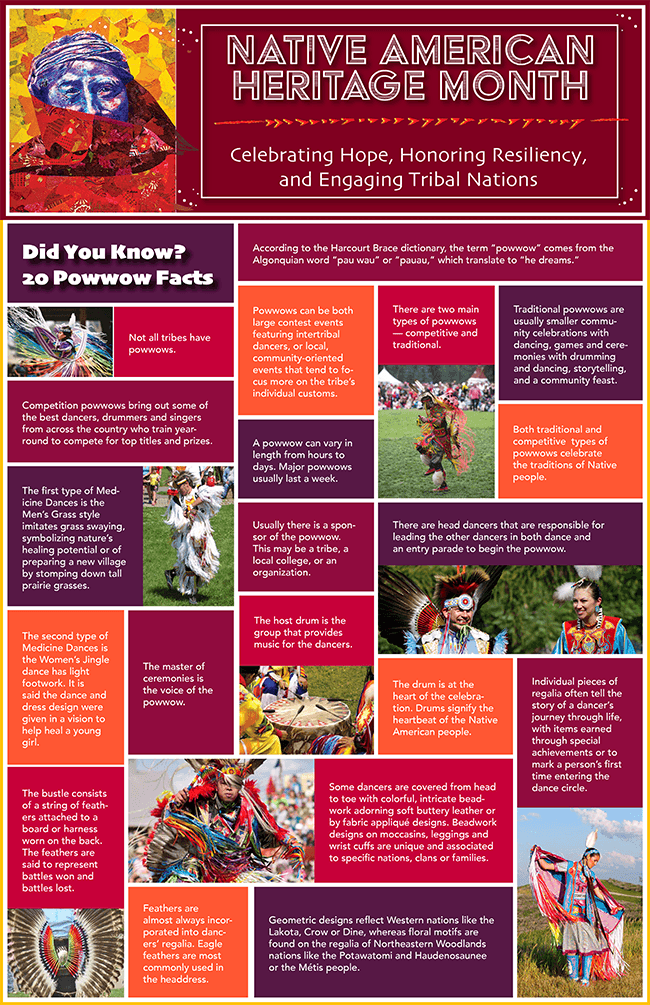Did You Know? 20 Facts About Powwows

Photo Credit: Rosanne Tackaberry/Alamy
Did You Know? 20 Facts About Powwows
According to the Harcourt Brace dictionary, the term “powwow” comes from the Algonquian word “pau wau” or “pauau,” which translate to “he dreams.”
Not all tribes have powwows.
Powwows can be both large contest events featuring intertribal dancers, or local, community-oriented events that tend to focus more on the tribe’s individual customs.
There are two main types of powwows — competitive and traditional.
Competition powwows bring out some of the best dancers, drummers and singers from across the country who train year-round to compete for top titles and prizes.
Traditional powwows are usually smaller community celebrations with dancing, games and ceremonies with drumming and dancing, storytelling, and a community feast.
Both types of powwows celebrate the traditions of Native people.
The first type of Medicine Dances is the Men’s Grass style imitates grass swaying, symbolizing nature’s healing potential or of preparing a new village by stomping down tall prairie grasses.
The second type of Medicine Dances is the Women’s Jingle dance has light footwork. It is said the dance and dress design were given in a vision to help heal a young girl.
A powwow can vary in length from hours to days. Major powwows usually last a week.
Usually there is a sponsor of the powwow. This may be a tribe, a local college, or an organization.
The master of ceremonies is the voice of the pow wow.
There are head dancers that are responsible for leading the other dancers in both dance and an entry parade to begin the powwow.
The host drum is the group that provides music for the dancers.
The drum is at the heart of the celebration. Drums signify the heartbeat of the Native American people.
Individual pieces of regalia often tell the story of a dancer’s journey through life, with items earned through special achievements or to mark a person’s first time entering the dance circle.
Feathers are almost always incorporated into dancers’ regalia. Eagle feathers are most commonly used in the headdress.
Some dancers are covered from head to toe with colorful, intricate beadwork adorning soft buttery leather or by fabric appliqué designs. Beadwork designs on moccasins, leggings and wrist cuffs are unique and associated to specific nations, clans or families.
he bustle consists of a string of feathers attached to a board or harness worn on the back. The feathers are said to represent battles won and battles lost.
Geometric designs reflect Western nations like the Lakota, Crow or Dine, whereas floral motifs are found on the regalia of Northeastern Woodlands nations like the Potawatomi and Haudenosaunee or the Métis people.
Sources
https://indiancountrytoday.com/archive/origins-of-the-grass-dance-Ufdxm_B9JkSiR0Y7GP-9MQ
https://www.westjetmagazine.com/story/article/a-guide-to-powwow-season-in-canada
Photo Credits
http://algonquinsofpikwakanagan.com/legacy/pow_wow_dance.php
Rosanne Tackaberry/Alamy
Simsimtko Whitewing, a Fancy shawl Dancer at Kamloopa, photo by Nathaniel Atakora Martin
Original artwork, Waihusiwa-Zuni House Chief, by Mark Shelton
Urban Woodswalker
Do you have a story idea for us? Do you want to submit a guest blog? If it's about equity, diversity, or inclusion, please submit to edi.stories@nih.gov.
For news, updates, and videos, subscribe or follow EDI on: Twitter, Instagram, Blog, YouTube.



